2006 Egypt
30 December 2006, Saturday; Marsam Hotel,
Luxor, LE110
We had not planned this day particularly
well so found ourselves with 90 minutes to spare at the Luxor train station at
08h00. Waiting for a train to Al-Balyana only due at 09h30. We made ourselves
at home in the first class tearoom, though we had booked second class tickets.
Our hosts did not seem to mind. Here Charl had an amusing incident with the
Egyptian Times salesman. He asked what the paper cost. LE6 was the answer. Too
much, said Charl. He then decided to see what price was printed on the paper.
He could not find the price on the top paper and flipped it over in
frustration, and there on the second paper was the printed price of LE1.50. The
price on the top paper had actually been blacked out. Charl waved the guy away,
but later paid him LE2 for the paper – and came back saying he and the salesman
were now best buddies.
Today was Eid – with fasting between
sunrise and sunset (I think) – and so food was a little hard to come by. Charl
managed to track down some mini French loaves, boiled eggs and processed cheese
while I had a second cup of tea and caught up the diary.
The train arrived and departed on time.
From the carriage you see the Nile, the road along it, the train tracks running
parallel – and the inevitable desert beyond the irrigated field. And three
hours later we disembarked in El-Balyana. Second class was comfortable enough
and only reeked faintly of urine. Despite which we enjoyed our makeshift
breakfast. And the sight of people at the stations dressed in bright holiday
clothes – all aglow in the glowing sun. En route we saw shaduffs and more
modern steel wheels constructed in curved, hollow segments – buckets in
themselves.
We disembarked with a young Korean in tow.
Who lives in Madrid where he studies architecture (loves both old and modern
Spanish architecture – as well as the culture). He is about to start his
two-year Masters and envisages spending another seven years in Spain.
We were met by the inevitable policeman –
who showed Charl his gun on request – and a taxi driver. Where are we from?
Where are we going? Where are we going afterwards? Which train are we getting?
Then into the taxi and down the road just a bit to collect our police escort –
after answering the same questions yet again. Our escort consisted of three
AK47-toting men in the back of a bakkie with a driver and (perhaps) one other!
And so off to Abydos 10km away.
According to legend, Osiris (ruler of the
dead) and his sister-wife Isis (protector of children; gifted with magical
powers) were earthly rulers. Their jealous brother Seth murdered Osiris and
scattered his body parts throughout the kingdom. Isis gathered and reassembled
the body parts and with the assistance of Anubis (jackal-headed god of the dead
/ embalming) created the first mummy. She brought Osiris back to life long
enough to conceive their son Horus (identified with the pharaoh; falcon-headed;
often wears the double crown of Upper and Lower Egypt). Horus defeated Seth to
become the living pharaoh; the resurrected Osiris became the ruler of the dead.
Osiris’s head was buried in Abydos which
became the place to be buried from 4000BC to 600AD.
The mastaba tombs of the first pharaohs are
here.
We had come to visit the Temple of Seti I
(1294-1279BC) which was built by Seti I and added to by his son Ramses II. It
is, after some restoration work, one of the most complete in Egypt. It was
dedicated to six major gods including Osiris, Isis, Horus, and Amun-Ra.
The second hypostyle hall contains 24
sandstone papyrus columns and the reliefs here were stunning. Beautifully and
delicately crafted. With a sense of proportion and movement and style and
physical reality. Many still flying their original colours. Lovely.
There are separate sanctuaries for each of
the gods to whom the temple is dedicated and one to Seti himself. Also a
corridor called the Gallery of the Kings which lists the pharaohs that preceded
Seti I. This list, and others like it, helped Egyptologists unravel the history
of ancient Egypt. Despite the fact that some names were purposefully omitted,
such as that of the female Pharaoh Hatshepsut and the heretic Akhenaten.
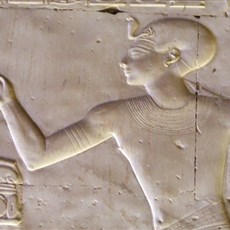
Abydos
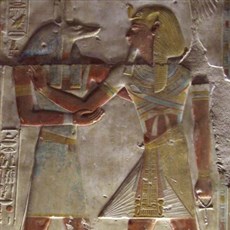
Abydos
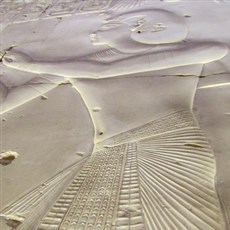
Abydos
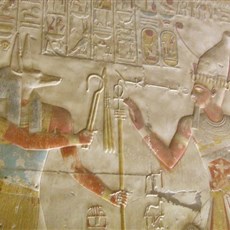
Abydos
Our taxi driver returned for us after an hour or so and whisked us back to town where we caught the train for the three-hour return journey to Luxor.
Luxor was a-buzz with people – including more women and girls out and about than we have seen to date (except perhaps in Cairo in the evenings). With most dressed in lovely bright holiday colours.
We dined, not especially well, near the station, strolled around the lit Luxor Temple (built by Amenhotep III (1390-1352BC)), and ferried ourselves across the limpid Nile. Just off the ferry we decided to buy some baklava being sold off the back of a truck. While we waited for the salesman to deal with earlier clients, we enjoyed watching the sales, weighing and packaging process. One of the customers showed Charl that he had paid LE5 for a big box of baklava – supposedly so we did not get overcharged!
We have begun to see the entire pricing process as a simple testing of what the market will bear at any given moment. In a buyer-beware environment. Fine by us.
Natasha told us, over our tea and baklava, that in the Arab culture “asking” is not begging. And that it is OK to ask – not shameful. And that both a yes and no answer is acceptable.
Nice day!
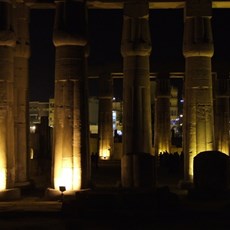
Luxor temple
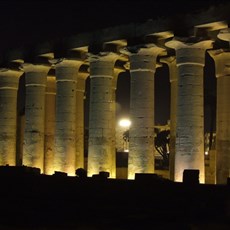
Luxor temple